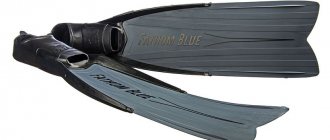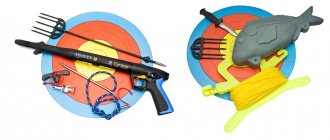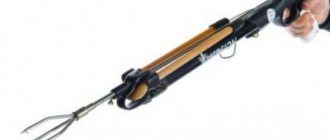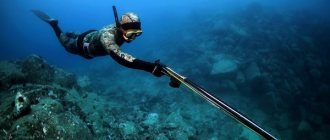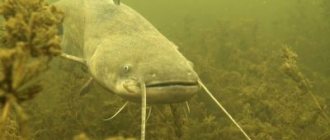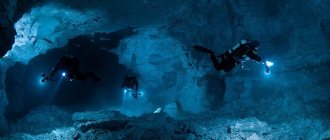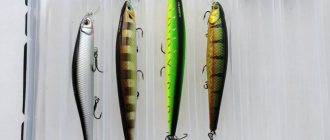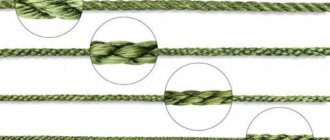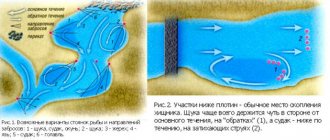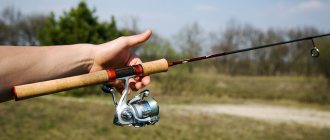General information about protective functions and types of wetsuits
To begin with, wetsuits are used by many athletes and hunters for a number of reasons. First of all, they are able to protect a person from possible damage under water and play the role of heat insulators. Largely thanks to their use, the “fishing” season is automatically extended, because in a high-quality wetsuit you can hunt underwater for a long time until it gets significantly colder.
Perhaps the very first thing you need to pay attention to when choosing a particular wetsuit model is its level of waterproofness. For this reason, diving suits, depending on their specific purpose, can be of several types.
Don't know how to choose a wetsuit for swimming and diving? Opt for the so-called wet suits. They received this name due to the fact that water seeps inside through “weak” places (for example, in the neck, cuff and zipper), then after a short time it takes on the temperature of the human body. At the same time, very weak heat transfer is observed, so a person is comfortable for a long time even in cool water. It is recommended to use wet suits at a water temperature of +5ºС.
Semi-dry workwear is protective equipment that differs from wet suits in its slightly improved degree of sealing and thermal insulation properties. These models feature double-sided cuffs on the open parts (sleeves), as well as waterproof zippers.
It’s easy to guess that water does not seep through dry suits at all, so the inside of the product remains dry, and the person is always warm. They are used if you are going to scuba dive at temperatures below +5ºС. Moreover, the operation of such protective clothing involves pumping air into the suit through special hoses. In general, dry suits should be used if you already have experience in diving and underwater diving. When considering options for choosing a wetsuit for wakeboarding and other surface extreme sports, you can immediately rule out a dry suit. In addition, it cannot be used for spearfishing.
Wetsuit design
According to their design, diving wetsuits are divided into several types:
- monosuit. There are two types: long (covers the diver’s legs and arms along the entire length) and short (legs and arms are half closed). Very comfortable, supports the natural stability of the diver;
- separate type. Consists of two parts: a jumpsuit with straps and a long-sleeved jacket with a built-in helmet. This type of suit has higher heat-protective properties compared to a monosuit, which are provided by applying one layer to another. It has another significant advantage - it is convenient to put on;
- combined. They are a set of a monosuit and diving jacket or a short and long monosuit. Due to their two-layer nature, such kits provide high heat-protective characteristics. Diving enthusiasts combine them depending on the expected depth of the dive, where the temperature can vary in different ranges.
Design features of wetsuits
Depending on the purpose, diving suits have different design features.
One-piece wetsuits are designed to protect the entire human body. They are completely fitted, have long sleeves and legs, and some of them can be equipped with neoprene hoods. If you don’t know how to choose a wetsuit for wakeboarding or for shallow dives in warm water, pay attention to short versions of such clothing. They differ from one-piece models in that they do not have a helmet, their trouser legs are always shortened above the knees, and the sleeves can be either long or cut off at the elbow.
A separate suit consists of overalls and a jacket with a zipper, and combined models can include all sorts of variations of this type of workwear. Special attention should be paid to the zipper, since it is through it that the largest amount of water gets into the suit. Therefore, when choosing a wetsuit, the zipper and its design should be inspected with special care.
Be sure to check the quality of the seams, especially if you are purchasing a wetsuit for cold water. How to choose workwear so that water does not seep through the seams? It’s very simple: to do this, you need to give preference to those suits whose seams are completely taped and reinforced inside and out, which makes the product completely airtight.
Features, properties.
Type of zipper.
Back zip – zipper on the back. As a rule, it is used on inexpensive simple wetsuits, because... easier to manufacture, but can easily be found on expensive wetsuits, although in addition to the zipper, valves or collars are placed on the back to protect against water ingress. Easy to put on. Depending on the complexity of the back zip system, the manufacturer may have several back zip systems of different price and quality, each with its own name.
simple cheap back zip
expensive back zip with protection against water ingress through the zipper
Chest zip – zipper on the chest. It is found on wetsuits of the mid-price category or on expensive ones. It allows much less water to pass through compared to a back zip , but putting on such a wetsuit is much heavier (although this is a matter of habit). Depending on the complexity of the chest zip chest zip systems of different price and quality .
No zip (Zipperless) - no zipper. Now such suits have appeared at O`Neill, Quiksilver, RipCurl, and soon other manufacturers will pick up. Theoretically, the penetration of water into such a suit is even less. Harder to put on than a chest zip.
- Windproof pads on chest and back.
- Specially reinforced knees for durability.
- Number of seams = that is, the number of pieces from which the wetsuit is assembled. The smaller the better, less water, more convenient to move.
- Collar - how comfortable the neck is in such a suit, the presence of adjustments.
- Neoprene used in production - weight, stretch, drying speed and other characteristics.
- Quality water blocking through wrists and shins.
- Special folds on the knees (on the reverse side) for maximum freedom of movement.
- Pockets for keys or sweets.
- The presence of fasteners on the wetsuit for accessories (if necessary) - for example, a hood or wet shoes...
- There can be a lot of chips and only you can decide what is essential.
A little about the material from which special clothing for spearfishing is made
Continuing to consider the question of how to choose the right wetsuit for spearfishing, you should study the material from which it is made. Basically, neoprene is used for this purpose, which has a porous structure and a smooth surface. In addition, it is rubber, which is considered an excellent insulator, which allows you to use a spearfishing wetsuit even in very cold water. How to choose a neoprene wetsuit of the right thickness? This is quite simple, you just need to decide on the climatic conditions in which the protective clothing is supposed to be used, and use the table below.
| h(mm), suit thickness | t(ºС) of water when immersed |
| 7-9 | 4-12 |
| 6-7 | 12-18 |
| 5-6 | 18-21 |
| 2-3.5 | 21-28 |
| 2 | 28+ |
Choosing the right wetsuit size for spearfishing
A wetsuit is special clothing designed for certain types of water sports, including spearfishing.
The purpose of using underwater equipment is thermal insulation, reducing the risk of injury and reducing the negative impact of the aquatic environment on the body. When the owner of underwater equipment is warm and comfortable, then such a hunt can last for hours and brings not only results, but also pleasure from the process. How to choose the right wetsuit for spearfishing is a question that everyone who wants to succeed in spearfishing should know the answer to. Well-chosen equipment allows a person to achieve maximum performance.
Choosing a wetsuit of the right size
Having decided on the thickness of the material, you can begin to select a wetsuit for spearfishing. How to choose the size of workwear so that it fits a person perfectly? First of all, you need to know your own height, the exact volume of the chest, abdominal circumference, girth in the pelvis, as well as biceps and hips. The table of standard sizes will tell you how to choose the right wetsuit.
| Wetsuit dimensions | Height, cm | Chest circumference, cm | Pelvic circumference, cm | Hip circumference, cm |
| S-46 | 164-170 | 92-96 | 80-84 | 96-99 |
| M-48 | 170-176 | 96-100 | 84-88 | 100-103 |
| ML-50 | 176-182 | 100-104 | 88-92 | 104-107 |
| L-52 | 178-182 | 104-108 | 92-96 | 107-110 |
| LX-54 | 182-188 | 108-112 | 96-100 | 111-114 |
| XL-56 | 182-188 | 112-116 | 100-104 | 114-117 |
| XXL-58 | 188-192 | 116-120 | 104-108 | 117-120 |
| XXXL-60 | 188-192 | 120-124 | 108-112 | 120-123 |
It is recommended to use shampoo for fitting, since putting on rubber clothes “dry” will be very problematic. Moreover, this should be done very carefully so as not to tear the material of the product. When wearing a wetsuit, it should be comfortable, and it must fit snugly to the body. Try bending in a suit and see how many and what size folds appear on the stomach and in the fold areas.
Remember that every fold on the suit is a potential reservoir for water, so the fewer there are, the better the fit of the wetsuit will be. Otherwise, this may lead to the person simply freezing while under water. Suits for scuba diving are also called open-pore or sticky suits, since they stick tightly to a person’s skin, while almost completely eliminating the circulation of air inside. This will be useful to know for anyone who is interested in how to choose a diving suit.
How to choose a wetsuit
1.Choose the thickness of the main body correctly. Hunting wetsuits consist of two parts, high pants (Long John) and a jacket, this allows you to abandon the most “vulnerable” element to water - zippers. ⠀ Depending on the water temperature, the thickness of the wetsuit is selected. If you choose it incorrectly, you can freeze or overheat, which is also very dangerous. So, for spearfishing in warm seas at a water temperature of +21 degrees, 3 mm wetsuits are chosen. For immersion in water in the summer in the middle zone, 5 mm suits are used. For cold water, wetsuits with a thickness of 7 mm or more are selected. ⠀ Approximate dependence of water temperature and suit thickness for a comfortable dive: Temperature-Thickness: 4-12C - 9-10mm 10-18C - 7mm 17-21C - 5mm 21C and above - 3mm. ⠀ 2. Choose the right external coating. The outside of the wetsuit can be “naked” - smooth for better gliding, but quite sensitive to mechanical damage. Or it is covered with a fabric elastic covering - a more durable option, but less “slippery”, and in cold conditions (wind, sub-zero temperatures) the fabric takes longer to dry than “naked” neoprene, so the diver runs the risk of freezing faster. ⠀ There may be an “open time” inside the wetsuit, in this case we have a tighter grip with the skin (neoprene “sucks” to the skin), water does not get inside, which guarantees better thermal insulation. But the suit must be put on using a soap solution or water hammer in water. ⠀ The second option is with fabric inside. When the inner surface of the wetsuit is lined with fabric. In this case, it is easier to put on a HC, but it will retain heat less well, since air and water will circulate between the skin and the fabric. ⠀ 3. The structure of neoprene is foam (sponge). When you dive, it contracts under the influence of water. The structure of neoprene has a kind of “memory” that continually returns the foam to its original thickness after compression. It is impossible to objectively determine how long this “memory” will work, since its service life depends on several factors. ⠀ The first factor depends directly on the neoprene itself. The neoprene board, from which sheets are cut in layers, is a large sponge consisting of many rubber cells with air inside. It is almost impossible to create two neoprene boards with exactly the same density and weight. And therefore it is impossible to obtain absolutely identical neoprene sheets. These are features of the neoprene creation process, and they are the same for all factories. ⠀ The second factor is how you use the suit. This refers to how you dive. If you dive deep, the compression will be higher. This also applies to how you store your suit when not diving. ⠀ In the world market, all the most famous spearfishing equipment companies must choose neoprene, which will show good softness and long life. But these two characteristics are opposite to each other. A soft suit will not last as long as a hard suit. But at the same time, a suit made of rigid (poorly stretchable) neoprene will be inconvenient to use. ⠀ SHEICO neoprene is the most used in spearfishing around the world simply because it offers an excellent softness/life/price ratio. ⠀ About 10-15 years ago, Japanese neoprene manufacturers were very famous in the spearfishing market due to their high quality. But then SHEICO entered the market with new materials. YAMAMOTO then began to compete with Sheiko in the global market, but was forced to reduce quality in order to remain competitive on price. ⠀ Due to the different organization in these two companies, YAMAMOTO has lost almost the entire export market, and now its neoprene is used by only a few companies in the world. Currently, there are several Japanese manufacturers that still survive by selling neoprene sheets to the spearfishing suit market. But the prices of such sheets are 5 times higher than those of SHEICO. Japanese neoprene is chosen only for individual tailoring of suits. But this is a different market, and it cannot be compared with the standard one.
4.Choose the correct size of the main body. When choosing a wetsuit size, it is important that the suit fits very closely to your body, especially if the inside of the wetsuit is open pore. This is even more true when purchasing a wetsuit through an online store that is not located in your place of residence. ⠀ The first thing that needs to be determined is the parameters of your body: 1. HEIGHT 2. WEIGHT 3. Chest girth 4. Waist girth 5. Hip girth ⠀ It is necessary to take measurements with a relaxed body, without inflating your stomach or holding your breath. Simple, natural state. Measurements must be taken on a naked body. You will need an assistant. The meter should not be pulled too tight or allowed to become saggy. You can always contact us for advice on measurements. ⠀ Now that you have the parameters, you need to choose your size using the wetsuit manufacturer’s size chart. If there is a deviation of more than 2cm, this may cause the water in the wetsuit to circulate and you will lose heat. And, conversely, with strong compression of the suit, movements will be hampered and blood circulation will be impaired, which also leads to heat loss and difficulties during scuba diving. Remember, the best wetsuit is the one that fits well. ⠀ 5. Choose the color of the Civil Code correctly. A camouflage top has a certain significance when hunting in very clear bodies of water - in the seas and oceans. ⠀ Freshwater fish, living in rather muddy water, focus more not on vision, but on other senses (on the same lateral line). Therefore, by saving a little on the price and taking a black rather than camouflage suit, you will not lose anything in terms of hunting success.
What should be included in a hunting wetsuit?
There is no need for professionals to explain all the intricacies of choosing models of special clothing for spearfishing. But if a novice diver is interested in the question of how to choose a wetsuit for hunting, then he needs to know several subtleties that are unique to this product.
So, even if the salesperson in the store assures you that this is the “same” wetsuit for hunting, do not rush to try it on. First, look carefully at the chest area in the front part: there must be a non-slip hard pad here, which is intended for reloading a crossbow or shotguns with a rubber striker.
The folds are considered the most vulnerable and rubbing parts of the suit, so they must be equipped with special linings made of a variety of materials that are difficult to wash. These can be polymer, rubber, supratex or Kevlar elements.
Types of wetsuits
Before considering the features of swimming equipment, you need to understand how to choose the right wetsuit according to the type of product.
Wet
This type of suit is the cheapest, but also one of the best in terms of comfort. The models are created using an unusual “heating” method. With the help of zipper, as well as some unsealed parts of the equipment, up to 1 liter of water penetrates inside, which does not flow out of the suit. This makes it possible to warm it up with the help of the swimmer’s body and create a certain layer between the skin and the wetsuit itself, which helps reduce heat losses.
Often the thickness of this type will be 1-5 mm, so a person will be comfortable when swimming in the temperature range of 16-24 degrees. In addition, there are very thin models of wet suits on sale that are made from lycra, but they are recommended for use in warm water of 25-30 degrees. They are no longer used for insulation, but for protection against jellyfish, scratches in water, and other things.
Wet models are made from a neoprene shell, which can be supplemented with thermoplush or nylon. Through the use of auxiliary material, a little strength is added, and the insulating qualities are also increased, while all human movements remain free, without constraint.
Pros:
- Large selection of different models.
- Light weight.
- High degree of comfort.
- Excellent elasticity of the material.
- Affordable pricing policy.
Minuses:
- Thin materials, as a result of which the suit can be easily torn and damaged, and heat retention will be poorer.
- Long sleeve and pants versions are difficult to put on, so swimmers need to apply a specialized gel to their body.
Semi-dry
This is a middle option between a dry and wet type of wetsuit. The material used in production is quite dense - neoprene, which allows you to retain body heat well. The models have seals and zippers that do not get wet. Water may get under the equipment, but its volume will be up to 250 ml.
For the semi-dry type, it is customary to use materials 2-7 mm in thickness, so they are recommended for use in rivers and seas at temperatures of 10-20 degrees Celsius. Often, products consist of a couple of elements - a jacket and overalls, but manufacturers provide a helmet, boots, and other protective elements in the kit.
Pros:
- They make it possible to maintain and regulate temperature well under water.
- Convenient models to use with an optimal level of comfort.
- Low weight with high strength.
- The materials have virtually no effect on the swimmer's movements.
- They provide excellent protection for the body from possible damage.
The main disadvantage is the time spent under water - no more than 2 hours.
Dry
Such models are completely different from wet ones, since they are characterized by tightness and do not allow water to penetrate inside. The main advantage is the maximum retention of heat generated by a person. This is achieved by sewing together all parts of the suit, including the helmet, boots, seals, they serve to seal the cuffs on the arms, legs and neck. In addition, manufacturers provide protective thermal underwear and a gas-tight zipper.
There is an air valve in the middle of this product, which provides more comfort if the swimmer needs to use heavy equipment for work. The materials of the wetsuit are quite dense, 5-15 mm thick. While swimming, a person will feel stiffness in movements, which are most noticeable at depth. The main advantage of dry options is the ability to swim in water less than 0 degrees.
The products are quite expensive, so they are used more often by professionals rather than by amateurs. Due to their high density, it is recommended to use them for specific tasks when the swimmer does not need frequent maneuvers and movements. It is dry types of overalls that are used for long-term stays under water.
Pros:
- Completely sealed models.
- Possibility to use additional clothing or thermal underwear under the suit.
- It is almost impossible to freeze on land or in water.
- High strength materials.
- Allows maximum time to be in the water.
Minuses:
- During swimming, movements will be constrained.
- High cost of goods.
About additional functionality
When buying a wetsuit for spearfishing (we already know how to choose the right product), do not forget to purchase protective equipment such as knee pads, since, as practice shows, the knee area is one of the most vulnerable.
It may seem that having a large number of pockets can be useful for storing a variety of items in them. However, you should purchase models with the smallest number of various compartments and external tanks. Do not forget that any hard object in your pocket is potentially dangerous, since at any moment it can tear the material of the suit, thereby breaking its tightness.
I would like to note this nuance when choosing, which is related to the location of the lightning. You need to know that if it is located on the back side of the suit, it retains heat better, since the collar of the product in this case is located higher. It would be a good idea to ensure that the zipper is hidden under the rubber, since in this case leakage is minimized. Zippers on the legs and sleeves, which make it easier to put the suit on the body, should also be hidden.
Purpose
Wetsuits are an essential piece of diving equipment. A wetsuit protects you from the cooling effects of water, which can take away your body heat 25 times faster than air. You can, oddly enough, become hypothermic even in equatorial waters, since the body temperature is 36.6, and the temperature of even the warmest water is rarely above 30 degrees Celsius.
A difference of even six degrees causes the body to lose heat, and along with heat, energy. That is why wetsuits are necessary for diving not only in cold water, but also in warm tropical water. In addition, wetsuits protect against minor scratches, cuts, and accidental contact with jellyfish, corals and other marine flora and fauna.
With a wide variety of wetsuits to choose from, you need to choose one that will allow you to enjoy diving to the fullest.
Here are a few questions you should clear up before heading to your local store.
How to protect your palms and feet
It is known that fins are used for spearfishing to help move through the water. To avoid rubbing your feet, damaging them and freezing, it is recommended to wear special socks, as well as light and very durable boots. Socks can be up to 3mm thick, while rubber boots can be about 5mm thick. At the same time, they are equipped with a durable and thick sole, which protects the feet from punctures and injuries.
When deciding which wetsuit to choose for spearfishing, do not forget to protect your own hands. For these purposes, various mittens and thick gloves are provided that protect your hands from frostbite. This is especially true in late autumn or winter. For very cold water, 7mm thick gloves are available. They perfectly keep your hands warm under water, but you should remember that the thicker the product, the more difficult it is for your hands to perform various movements. In general, gloves with a thickness of up to 5 mm are very popular.
Taking measurements for a wetsuit
Important parameters to choose will be:
- chest girth;
- the length of the sleeve;
- distance from the beginning of the chest to the pelvis.
Measurement must be carried out according to the following recommendations:
- Select the tape that will be used to measure the suit.
- It is important not to hold your breath when taking measurements, but to measure your chest as you inhale.
- Hold the tape parallel to the floor while measuring your chest circumference.
- Determine how long the sleeve should be.
You can select your wetsuit size using the size chart. In general, it is important that the wetsuit fits very tightly, but does not squeeze or tighten the body. It’s not for nothing that it’s called the “second skin.” Since choosing the right size wetsuit means feeling comfortable in it, it’s worth saying a few words about fitting. Naturally, measuring it indoors will not be very convenient, so it is better to take accurate measurements and calmly try them on at home. Each manufacturer makes different products with their own characteristics. The main criterion should be one - high comfort of movement and stay in the water!
Wetsuit for spearfishing from Beuchat
Equipe Mundial ─ high quality wetsuit for spearfishing. How to choose additional equipment for it? The suit contains in its design everything necessary for diving under water. The inner surface of this model is made of an open-pore type, and it itself belongs to a separate type of protective clothing. The set consists of long overalls and a jacket. It has no zipper and is equipped with a neoprene helmet.
The suit fits tightly to the body, and restriction of movements on land and under water is minimized, since the model has a ready-made shape, taking into account all anatomical features and folds. The jacket is made of neoprene, the thickness of which is 7 mm, and the overalls are 5 mm thick. This wetsuit will be available to almost every spearfishing connoisseur, since its cost is 14 thousand rubles.
Looking for an ultra-stretchy and super soft wetsuit? Which company should I choose such a product at an affordable price? Pay attention to the Marlin Prestige model from Beuchat. Its manufacture is based on the use of elaskin material, which is a very soft neoprene, which ensures virtually unrestricted movements of the hunter under water. All suits have anti-friction linings. The cost of this product is 18 thousand rubles.
Main selection criteria
The type of wetsuit is not the only factor to consider when choosing scuba gear. It is very important to understand in advance the conditions of its operation and the purpose of immersion under water, since it is these indicators that determine the choice of material thickness. Standard neoprene thicknesses are 3, 5, 7 or 9 mm:
- The material thickness of 3 mm is intended for water temperatures of 23-25˚C.
- Material thickness 5 mm - suitable for water temperatures 18-22˚C.
- Material thickness 7 mm - most suitable for water 6-18˚C.
- Material thickness 9 mm – for water below 6˚C.
To choose the most suitable wetsuit, the features of its tailoring are also important.
The best option would be one that is made according to individual measurements, since it will best meet the anatomical parameters of the swimmer’s body and the declared characteristics of the material used. If the suit turns out to be even a little large or tight, then the thermal insulation properties of the entire set will be reduced to zero. In addition to the above, when choosing a wetsuit, you need to pay attention to the following factors:
- Type of cut, seams and fasteners.
- The presence of fixing pads for holding various accessories that you need to take with you when swimming.
- Ease of putting on clothes and their design.
By purchasing a wetsuit from our specialized company that specializes in tailoring clothing for underwater sports, you will be provided with professional advice from a specialist, qualified assistance in choosing additional equipment and warranty support.
Sporasub and OMER wetsuits
When considering the question of how to choose a wetsuit for swimming and spearfishing, it is necessary to highlight the products of the world-famous brands OMER and Sporasub.
A wetsuit for spearfishing (we already know how to choose the right one) Baltik is a special development by Italian specialists from the Sporasub company for a person’s comfortable stay in the cold waters of reservoirs. The outer covering has a nylon layer and camouflage coloring, which makes the hunter invisible against the background of the bottom of the reservoir and under water. The thickness of the neoprene is 7 mm, and the jacket has an elastic helmet with a special valve that can release excess air. The suit is a separate set of clothes consisting of pants and a jacket, and its cost is 14.5 thousand rubles.
A similar camouflage model of the Camu wetsuit can be purchased from the Italian company OMER. This lightweight version of workwear for spearfishing, intended for use in warm waters (3 mm thick) costs 13 thousand rubles. The camouflage coating of these products makes hunters virtually invisible, which is especially valuable when waiting for prey for a long time.
Features and purpose of the wetsuit
Without considering the type of underwater activity, you need to know how to determine your wetsuit size. To do this, you should understand that the material from which the product is made is quite elastic and stretches by 1-2 sizes. However, neoprene can only perform its thermal protection functions if the suit fits tightly to your body. It follows that if your clothing size is 48-50, then you can take a suit - 46-48, but no less. It is important to know the properties of the material so as not to make a mistake with the thickness of the suit. Neoprene is a polymer synthetic material filled with air bubbles, which give it significant softness. At high underwater pressure, the bubble will burst, which means the water temperature will be more noticeable. In order for a wetsuit to withstand both low temperature and high pressure, the material must be at least 7mm thick. You can buy wetsuits for diving on our website in the “wetsuits for diving” section, as well as a wetsuit for snorkeling in the “wetsuit for snorkeling” section
You should pay special attention to how to choose the size of a wetsuit for spearfishing. In addition to the basic requirements, several more points are added to it. It turns out that a spearfishing suit should:
- be light, strong and wear-resistant;
- do not hinder movement;
- reliably retain heat inside the suit.
An underwater hunter can spend more time in the water without dynamic movements. Therefore, heat resistance comes to the fore. Therefore, if the dimensions of a wetsuit for swimming can be the same as yours, then for spearfishing the size should be slightly smaller. It is very important that there is not too much space left between the body and the suit, which will fill with cold water and not warm up.
How to properly use and store a wetsuit
We have already said that the wetsuit should fit snugly, but there should not be too much pressure or looseness. A properly selected product will provide you with comfort and the ability to enjoy scuba diving and hunting for many years.
It is necessary to pay special attention to the use of suits in the salty waters of seas and lakes. The fact is that when the water dries, layers of salt remain on the surface of the workwear, which can very quickly corrode neoprene. Therefore, after the suit has been used, it must be thoroughly rinsed with fresh or running water, which you can fill a canister with and take with you to the pond, which will always bring the workwear into proper condition. It is also recommended to ensure that the wetsuit does not dry out completely to avoid cracking and possible depressurization. Therefore, even during long-term storage, the wetsuit must be stored clean and damp.
As for drying the suit, it cannot be done in the open sun. Kinks of the product are also not allowed, as this can increase its volume and the elongated places will quickly fill with water. In addition, kinks can lead to rapid cracking of neoprene. Therefore, the wetsuit must be dried in the shade in a suspended state, which is guaranteed to extend its service life.
Classification of diving suits
The presence of a properly selected wetsuit on a person who is diving significantly expands his capabilities and increases the duration of his stay in water, including cold water. After all, the main task of an underwater suit is thermal protection, since in water the heat loss of a swimmer’s body is much higher than in air. No person can withstand being in cold water for many hours without the appropriate wetsuit.
Depending on the purpose and water temperature, there are several types of wetsuits:
- Wet. They are made of special neoprene, impregnated with a composition that ensures minimal penetration of water inside. Neoprene is the best thermal insulating material that can retain body heat in cold water. This clothing is suitable for those who engage in long-term underwater hunting, diving and special types of water sports.
- Dry or waterproof. They are made of rubberized material with a heat-insulating lining, which perfectly retains body heat and protects it from water penetration. The clothing is suitable for professional diving and diving work, designed for diving to great depths with water temperatures below +15˚C.
- Semi-dry. Made from dense neoprene with special sealed cuffs made of silicone material. A semi-dry suit should fit as snugly as possible to retain heat. This clothing is more suitable for professionals.
According to the sewing method, wetsuits can be divided into monosuits with a helmet, open overalls and separate suits, which consist of two elements (pants and a jacket). Despite the wide variety of diving suits, this equipment must be purchased solely for its intended purpose, since each sport, water temperature and period of stay under water has its own type of clothing.
Dry or wet?
If you are planning short-term dives in warm water with a temperature of +28°C and above, then a T-shirt and shorts made of neoprene with a thickness of 2-3 mm are most suitable for you.
For longer dives or in cooler water, it is advisable to choose wetsuit . The thermal protective effect of the suit is not based on isolating the swimmer’s body from water, but on preventing its circulation, which prevents intense convective heat transfer. This, of course, does not protect against heat loss at all, but it limits heat exchange so much that the swimmer can remain under water for a very long time. The great advantage of a wet suit compared to a dry suit is the preservation of its heat-protective properties in case of minor damage or cuts, since it is not initially waterproof. Much attention should be paid to the design of the wetsuit as a factor that increases operating comfort and reduces water circulation.
To ensure normal functioning of the body when diving to medium and great depths, as well as in cold water (from 15°C and below), it is recommended to use dry wetsuits. This is due to the fact that a neoprene wetsuit tends to shrink under pressure, which leads to a decrease in its thickness and, as a result, a deterioration in its thermal insulation properties. A dry suit is water- and gas-tight. Such suits are usually used together with hygienic and heat-insulating underwear.
Dry suits made of neoprene are very popular. A distinctive quality of such a wetsuit is the ability to use it without additional heat-insulating underwear in water with temperatures up to 13°C, which has a positive effect on the swimmer’s mobility. In order to eliminate the problem of neoprene crimping during immersion and preserve both heat-insulating properties and buoyancy, so-called “compression” neoprene is used. During production, such neoprene is “foamed” under increased pressure. As a result, its properties remain unchanged to depths of 30-40 m. For the same purposes, neoprene is used with a volume of gas bubbles reduced by 3-4 times, or with increased rigidity of rubber such as Rabertech or crashed. However, in the latter case, the elasticity of the wetsuit, especially noticeable during long swimming, leaves much to be desired.
Dry wetsuits, called “membrane” suits, are also used. To produce such suits, various combinations of nylon with polymeric materials or rubbers are used, for example, nylon-polyurethane (poldura) or nylon-butyl rubber-nylon (trilaminate). The use of combinations of several materials is driven by the desire to use the best qualities of each of them. The main quality of membrane wetsuit materials is lightness. But all materials for membrane suits have one drawback - low elasticity. As a result, to ensure freedom of movement, the suit is made “baggy”.
When choosing a drysuit, you should pay attention to how much the valve button protrudes above the main valve body. In this case, the swimmer’s increased attention to this part of the equipment is required, since such a design, on the one hand, makes it easier to operate the valve with thick mittens or gloves, and on the other hand, when the button touches the ground or other objects, unauthorized inflation of the wetsuit is possible, which is extremely undesirable.
